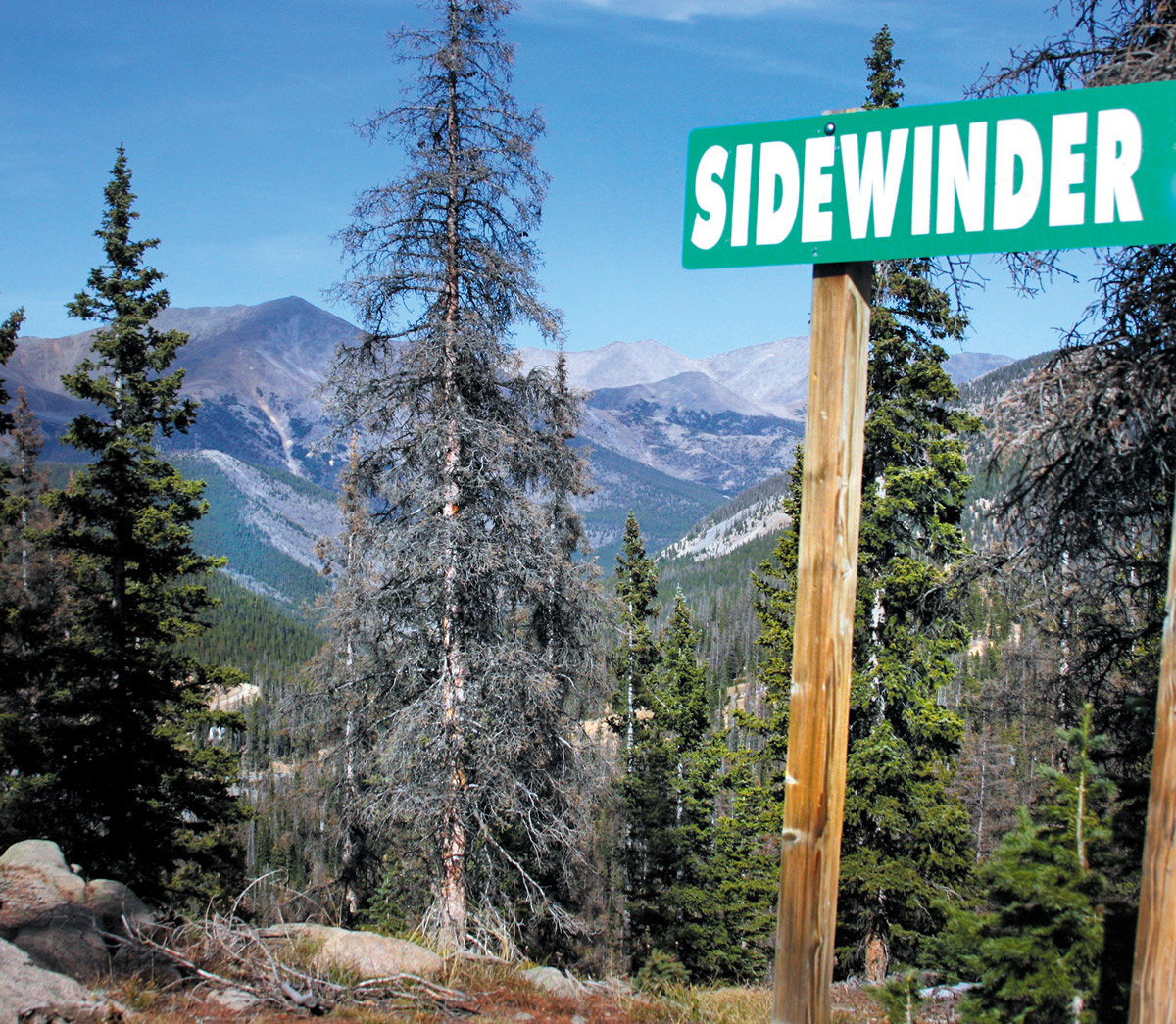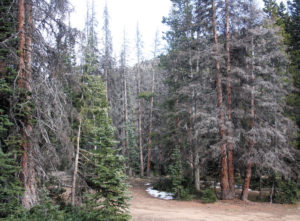
By Mike Rosso
The sound of chainsaws echoed across the landscape as I stood near the top of the Sidewinder ski run at Monarch Mountain this past October.
Crews are busy removing dead and dying trees which are potentially threatening lifts and other structures at the ski area, a result of the spruce beetle (Dendroctonus rufipennis) infestation which has impacted up to 90 percent of the Engelmann spruce trees over six inches in diameter and 4.5 feet tall, according to Alex Rudney, Silviculturist with the Pike-San Isabel National Forest.
Another pest, the Western balsam bark beetle (Dryocoetes confusus) is having at the subalpine fir trees also found in the Monarch Ski area Special Use Permit (SUP) boundary.

Managers at Monarch Mountain noticed significant die-off of the subapline fir in 2012 and met with representatives of Pike and San Isabel National Forests and Cimarron National Grasslands, under whom the SUP is managed, according to Molly Pitts, Oregon State University graduate student. A Vegetation Management Plan was recommended that would address vegetation within the developed ski area and provide treatment guidance.
“Spruce beetles, when in an endemic state, feed on scattered blowdown and broken spruce trees. They are always present in low numbers throughout the forest, infesting these damaged trees. Large winds can cause large blowdown events that lead to a nearly unlimited production of food for the beetles and allow them to increase their numbers,” said Rudney.
“A large blowdown in southwestern Colorado in the late 1990s, combined with an early 2000s drought, set on course the beetle infestation we see around Monarch Pass now. In addition, the beetles found hundreds of thousands of acres of dense, large, old host material, perfect for the beetles proliferation. The same epidemic that started in the early 2000s continues to this day,” he continued.
He went on to explain that as the number of beetles increase and exhaust the downed food supply, the beetles then turn to the standing green trees. During periods of drought, the pitch production the trees, normally used as a defense mechanism, is compromised due to the lack of water.
“Older denser stands are more susceptible for the same reasons related to pitch production. Mild winter temperatures may contribute to increased survival of broods as cold weather can produce heavy mortality among overwintering beetles,” he added.
[InContentAdTwo] As part of the beetle mitigation at the ski area, downing of dead trees began in 2015-2016 with the removal of approximately 100 trees, according to Scott Pressly, vice president of Monarch Mountain Operations. That number increased to nearly 700 in 2017, most being removed to decrease hazards threatening lifts and structures.
“The goals is to thin and mitigate the issue,” he said.
Might the thinning of trees affect terrain and offer more tree corridors for skiers?
“Yes,” said Pressly. “The process should thin out more ski routes. It [the beetle kill] is a natural process; we’re just trying to embrace it.”
Employees at Monarch who received S-212 Wildland Chainsaw Certification are doing most of the mitigation work. Custom classes were taught at Colorado Fire Camp a 501(c)(3) non-profit wildland firefighter school located in Maysville, and it is likely that students of that facility will be brought on the assist with the mitigation efforts at Monarch. Many of the harvested trees are being sold as fuelwood or as timber and shipped to lumber mills.
Studies are currently being done to determine the impact of the beetle kill and tree removal on the soils and wildlife of the area, and the replanting of trees will be part of the long-term program, according to Pressly.

The ski area is within the larger Monarch Pass Vegetation Management Project, which involves the removal of insect infested and susceptible trees in the Monarch Pass area. The percentages of affected timber within the Monarch pass Project Area are similar to those within the ski area for the respective species. The U.S. Forest Service is currently undergoing National Environmental Policy Act review under The Monarch Pass Vegetation Management Project Categorical Exclusion, according to Rudney.
“We propose to remove dead and infested trees, thin live trees and remove them from the project area to reduce the extent of spruce beetle infestation, Western balsam bark beetle infestation, improve forest resiliency to insect and disease infestations, reduce fuel loading, protect infrastructure and provide for firefighter and public safety in the Monarch Pass area.”
“We have undertaken a preventative spraying program within the Monarch Park Campground to prevent infestation of certain high-value campground trees. In addition, hazard trees are being cut and removed from the campground and the ski area as well,” he explained.
This year, Monarch Mountain is partnering with the National Forest Foundation Ski Conservation Fund and Forest Stewardship Fund which support the implementation of on-the-ground conservation and restoration projects, such as the work being done on Monarch Pass. Skiers can donate to the fund when they purchase a lift ticket or season pass.
What’s the long-range prognosis for the forests on Monarch Pass?
Rudney explained, “The beetles in the Monarch Pass area are getting close to eating themselves out of house and home. Once they have killed their host trees they must move on to new green host trees to produce their next brood. We should see the active number of beetles decline in the next two or three years because they will have run out of available host material.”
Meanwhile, locals are likely going to have to get used to the site of gray forests which were once thick and green.


